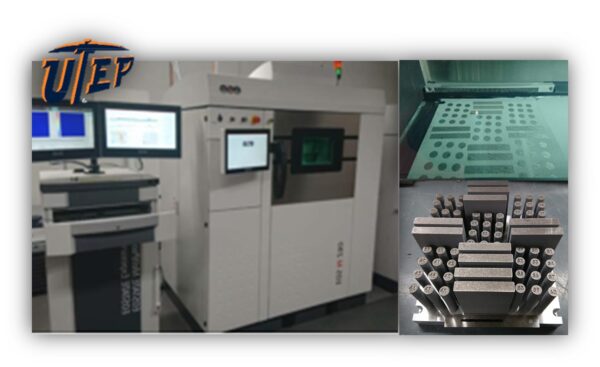


EOS M290 laser powder bed fusion system housed at the University of Texas at El Paso
Problem
Aluminum alloys have high strength-to-weight ratios, excellent thermal properties, and low material costs making them good candidates to replace the use of titanium alloys for use in the sustainment of legacy defense systems. Laser powder bed fusion (LPBF) technologies can provide advantages to manufacturing aluminum alloys such as superior mechanical and formability properties thanks to a refined grain structure caused by a very high solidification rate. There is not much public data to help the adoption of AlSi10Mg as an additive manufacturing (AM) material. A better understanding of the effects of thermal treatments and service temperatures on the long-term performance of AlSi10Mg will help to close the knowledge gap.
Objective
The objective of this program was to enable the use of aluminum alloys for high-temperature applications by understanding the effects of thermal treatments and service temperatures on the long-term performance of this alloy. Specifically, this effort seeks to document the material state and microstructure of additively manufactured AlSi10Mg for certification and qualification of components that are critical for the sustainment of legacy defense systems.
Technical Approach
The University of Texas at El Paso (UTEP) led the effort. The first phase involved material parameter verification including powder acquisition and characterization, material parameter validation, and the building of sample analysis cubes for characterization. Up to five post-processing techniques for heat treatment were investigated resulting in a down-selection for examining the thermal treatments and service temperature effects on additively manufactured AlSi10Mg. Tensile samples were constructed in the EOS M290 and SLM M280 systems in the Z and XY orientations. Specimens were post-processed in the “as built,” T6, HIP, HIP +T6 states, with up to two additional heat treatments identified and developed. Subsequently, 10, 100, and 1000 hours of exposure at an aging temperature of 350°F were studied.
Accomplishments
The project produced a comprehensive overview of post-process heat treatments for LPBF fabricated AlSi10Mg alloy consisting of stress-relief (SR) anneals at 190 oC and 285 oC for 2 h, HIP at 515 oC for 3 h, HIP + T6 treatment for 6 h, and final aging of each of these 5 conditions at 177 oC for up to 1000 h. This resulted in 40 experimental variants: 20 in the vertical and 20 in the horizontal tensile direction. The highest strength (UTS) of ~ 460 MPa occurred for the as-built, unaged condition; with a corresponding elongation of ~ 8 %, aging of the as-built specimens reduced the strength by ~ 10 %. SR anneal at 190 oC also reduced the strength slightly while at the 285 oC, SR treatment the strength was reduced by ~ 40 % and the elongation doubled. HIP treatment resulted in a UTS of ~ 140 MPa and an elongation of > 30 %. The aging treatment reduced the UTS but had little effect on the elongation. HIP + T6 treatment followed by aging reduced the UTS from ~ 240 MPa (for no aging) to ~ 95 MPa (at 1000 h) while the corresponding elongations increased from ~ 17 % to ~ 28 %, respectively. Vickers micro-indentation hardness (HV) measurements closely corresponded with the yield stress (YS) values and ranged from high values around HV 137 for the as-built specimens to low values around HV 47 for HIP specimens.
Project Participants
Project Principal

Other Project Participants
Public Participants
- U.S. Department of Defense
